24 books about Signals & Signal Processing

Advanced Signal Processing
D.J. Creasey
The Institution of Engineering and Technology, 1985
The IEE in association with the IEEE and IERE organised an international specialist seminar on Advanced Signal Processing in Radar, Sonar and Communications, in September 1984. The Seminar was held at the University of Warwick and this book contains a collection of the papers presented. Some of the material is of a tutorial nature while some of it represents the latest state-of-the-art. Inevitably, because signal processing is limited by the components available, the subject matter ranges from the individual components and their impact on signal processing, through to the design and assessment of complete systems. The individual contributions come from industry, educational establishments and government research laboratories in the UK and the USA. The order of presentation in the book mainly follows the order in which the papers were presented at the seminar.
[more]
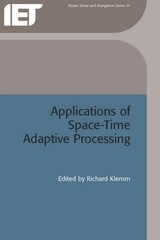
Applications of Space-Time Adaptive Processing
Richard Klemm
The Institution of Engineering and Technology, 2004
This new book from Richard Klemm, author of the highly successful Principles of Space-time Adaptive Processing (IEE,2002), examines the various applications of space-time adaptive processing including applications in OTH-radar, ground target tracking, STAP in real world clutter environments, jammer cancellation, superresolution, active sonar, seismics and communications. Including contributions from distinguished international authors, the book provides a unique overview of the field of space-time procesing. The book is divided in two parts; the first dealing with the classical adaptive suppression of airbourne and space based radar clutter and the second comprising of miscellaneous applications in other fields such as communications, underwater sound and seismics.
[more]
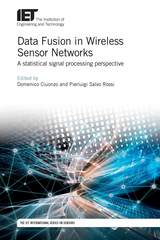
Data Fusion in Wireless Sensor Networks
A statistical signal processing perspective
Domenico Ciuonzo
The Institution of Engineering and Technology, 2019
The role of data fusion has been expanding in recent years through the incorporation of pervasive applications, where the physical infrastructure is coupled with information and communication technologies, such as wireless sensor networks for the internet of things (IoT), e-health and Industry 4.0. In this edited reference, the authors provide advanced tools for the design, analysis and implementation of inference algorithms in wireless sensor networks.
[more]
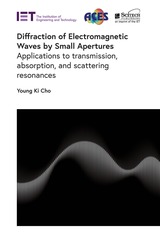
Diffraction of Electromagnetic Waves by Small Apertures
Applications to transmission, absorption, and scattering resonances
Young Ki Cho
The Institution of Engineering and Technology, 2024
This book deals with low-frequency diffraction characteristics of small aperture structures such as a narrow slit and a small hole and their periodic structures, with emphasis on the transmission maximum phenomena through those structures. A narrow slit structure in a conducting plane has been used as a simple model for a narrow slot planar antenna, for example, whereas a small hole structure has been widely used as an aperture-coupling element in a transmission cavity filter or a directional coupler in the microwave regime.
[more]

Digital Signal Filtering, Analysis and Restoration
Jiří Jan
The Institution of Engineering and Technology, 2000
The processing and analysis of signals and data is today a fast-growing and crucial activity in a diverse range of fields, not only in communications and image technology itself but in almost every other research area in science. The purpose of this book is to explain some of the theoretical concepts that underly the methods now in common use. The author starts from the assumption that some knowledge of the basic principles should be in the toolkit of every engineer or scientist working with signals or data.
[more]

Digital Signal Processing
Principles, devices and applications
N.B. Jones
The Institution of Engineering and Technology, 1990
Recent progress in the design and production of digital signal processing (DSP) devices has provided significant new opportunities to workers in the already extensive field of signal processing. It is now possible to contemplate the use of DSP techniques in cost-sensitive wide bandwidth applications, thereby making more effective use of the large body of available signal processing knowledge. Digital signal processing, long the province of telecommunications is, in both research and applications contexts, of growing importance in fields of medical signal analysis, industrial control (particularly robotics), in the analysis and synthesis of speech and in both audio and video entertainment systems. The growing demand for engineering skills in these areas has led to the writing of this book and the presentation of the material of the book at an lEE-sponsored Vacation School at the University of Leicester.
[more]
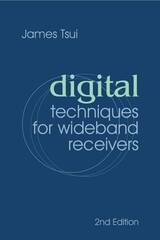
Digital Techniques for Wideband Receivers
James B. Tsui
The Institution of Engineering and Technology, 2004
This newly updated, second edition of Digital Techniques for Wideband Receivers is a current, comprehensive design guide for your digital processing work with today's complex receiver systems. Brand new material brings you up-to-date with the latest information on wideband electronic warfare receivers, the ADC testing procedure, frequency channelization and decoding schemes, and the operation of monobit receivers. The book shows you how to effectively evaluate ADCs, offers insight on building electronic warfare receivers, and describes zero crossing techniques that are critical to new receiver design. From fundamental concepts and procedures to recent technology advances in digital receivers, you get practical solutions to all your demanding wideband receiver problems. This hands-on reference is packed with 1,103 equations and 315 illustrations that support key topics covered throughout the book.
[more]
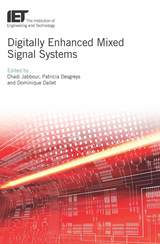
Digitally Enhanced Mixed Signal Systems
Chadi Jabbour
The Institution of Engineering and Technology, 2019
Digitally enhanced analog and mixed signal techniques are increasingly important to current and future circuit and system design. This book discusses how digital enhancement can be used to address key challenges relevant to analog components in terms of shrinking CMOS technology, increasing user demand for higher flexibility and data traffic in communications networks, and the drive to reduce power consumption.
[more]
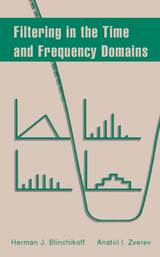
Filtering in the Time and Frequency Domains
Herman J. Blinchikoff
The Institution of Engineering and Technology, 2001
Long regarded as a classic of filter theory and design, this book stands as the most comprehensive treatment of filtering techniques, devices and concepts as well as pertinent mathematical relationships. Analysis and theory are supplemented by detailed design curves, fully explained examples and problem and answer sections. Discussed are the derivation of filtering functions, Fourier, Laplace, Hilbert and z transforms, lowpass responses, the transformation of lowpass into other filter types, the all-pass function, the effect of losses on theoretical responses, matched filtering, methods of time-domain synthesis, and digital filtering. This book is invaluable for engineers other than those who are filter design specialists who need to know about the possibilities and limits of the filtering process in order to use filters competently and confidently in their system designs.
[more]

Foundations of Digital Signal Processing
Theory, algorithms and hardware design
Patrick Gaydecki
The Institution of Engineering and Technology, 2004
Foundations of Digital Signal Processing: Theory, algorithms and hardware design starts by introducing the mathematical foundations of DSP, assuming little prior knowledge of the subject from the reader, and moves on to discuss more complex topics such as Fourier, Laplace and digital filtering. It provides detailed information on off-line, real-time and DSP programming, and guides the reader through advanced topics such as DSP hardware design, FIR and IIR filter design and difference equation manipulation.
[more]

Integral Equations for Real-Life Multiscale Electromagnetic Problems
Francesca Vipiana
The Institution of Engineering and Technology, 2024
Integral Equations for Real-Life Multiscale Electromagnetic Problems brings together and explains the main available approaches for the numerical solution of surface integral equations that can be used to analyse real-world multi-scale electromagnetic problems. In computational electromagnetics, formulations based on surface integral equations are currently the most commonly-used option for the analysis of electrically large and complex structures, but it is essential to have available state-of-the-art techniques to solve them in an efficient and accurate way.
[more]

Modern Communications Systems
A First Course
Todor Cooklev
Michigan Publishing Services, 2024
Modern Communications Systems is a senior-level introduction to communications systems, although it can also serve as a reference for graduate students and practicing engineers. It includes treatments of wireless and cabled transmission, cellular systems, and analog and discrete modulation and coding techniques. Examples include Wi-Fi, 4G and 5G cellular systems and DSL. Multicarrier and MIMO communication systems are also covered. All of the mathematics needed is included where it is used rather than in an early introduction, which makes it easier to follow. An extensive number of end-of-chapter problems, along with summaries of concepts, formulas and terms presented in each chapter, are included. Solutions to the end-of-chapter problems are available to instructors teaching from the book.
[more]
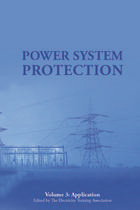
Power System Protection
Application, Volume 3
The Electricity Training Association Electricity Training Association
The Institution of Engineering and Technology, 1995
The worldwide growth in demand for electricity has forced the pace of developments in electrical power system design to meet consumer needs for reliable, secure and cheap supplies. Power system protection, as a technology essential to high quality supply, is widely recognised as a specialism of growing and often critical importance, in which power system needs and technological progress have combined to result in rapid developments in policy and practice in recent years. In the United Kingdom, the need for appropriate training in power system protection was recognised in the early 1960s with the launch of a correspondence course from which these books emerged and have since developed designed to meet the needs of protection staff throughout the world.
[more]
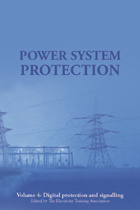
Power System Protection
Digital protection and signalling, Volume 4
The Electricity Training Association Electricity Training Association
The Institution of Engineering and Technology, 1995
The worldwide growth in demand for electricity has forced the pace of developments in electrical power system design to meet consumer needs for reliable, secure and cheap supplies. Power system protection, as a technology essential to high quality supply, is widely recognised as a specialism of growing and often critical importance, in which power system needs and technological progress have combined to result in rapid developments in policy and practice in recent years. In the United Kingdom, the need for appropriate training in power system protection was recognised in the early 1960s with the launch of a correspondence course from which these books emerged and have since developed designed to meet the needs of protection staff throughout the world.
[more]
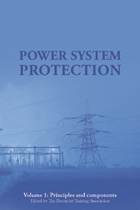
Power System Protection
Principles and components, Volume 1
The Electricity Training Association Electricity Training Association
The Institution of Engineering and Technology, 1995
The worldwide growth in demand for electricity has forced the pace of developments in electrical power system design to meet consumer needs for reliable, secure and cheap supplies. Power system protection, as a technology essential to high quality supply, is widely recognised as a specialism of growing and often critical importance, in which power system needs and technological progress have combined to result in rapid developments in policy and practice in recent years. In the United Kingdom, the need for appropriate training in power system protection was recognised in the early 1960s with the launch of a correspondence course from which these books emerged and have since developed designed to meet the needs of protection staff throughout the world.
[more]
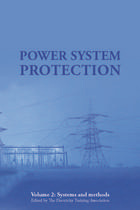
Power System Protection
Systems and methods, Volume 2
The Electricity Training Association Electricity Training Association
The Institution of Engineering and Technology, 1995
The worldwide growth in demand for electricity has forced the pace of developments in electrical power system design to meet consumer needs for reliable, secure and cheap supplies. Power system protection, as a technology essential to high quality supply, is widely recognised as a specialism of growing and often critical importance, in which power system needs and technological progress have combined to result in rapid developments in policy and practice in recent years. In the United Kingdom, the need for appropriate training in power system protection was recognised in the early 1960s with the launch of a correspondence course from which these books emerged and have since developed designed to meet the needs of protection staff throughout the world.
[more]
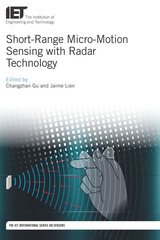
Short-Range Micro-Motion Sensing with Radar Technology
Changzhan Gu
The Institution of Engineering and Technology, 2019
Human hands are natural tools for performing actions and gestures that interact with the physical world. Radar technology allows for touchless wireless gesture sensing by transmitting radio frequency (RF) signals to the target, analyzing the backscattering reflections to extract the target's movements, and thereby accurately detecting gestures for Human Computer Interaction (HCI). A key advantage of this technology is that it allows interaction with machines without any need to attach a sensing device to the hands. Led by researchers from Google's Project Soli, the authors introduce the concept and underpinning technology, cover all design phases, and provide researchers and professionals with the latest advances and innovations in microwave and millimeter wave radar sensing to capture relative movements such as micro gestures.
[more]
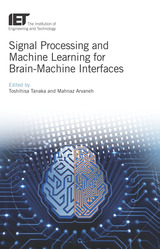
Signal Processing and Machine Learning for Brain-Machine Interfaces
Toshihisa Tanaka
The Institution of Engineering and Technology, 2018
Brain-machine interfacing or brain-computer interfacing (BMI/BCI) is an emerging and challenging technology used in engineering and neuroscience. The ultimate goal is to provide a pathway from the brain to the external world via mapping, assisting, augmenting or repairing human cognitive or sensory-motor functions.
[more]
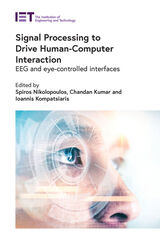
Signal Processing to Drive Human-Computer Interaction
EEG and eye-controlled interfaces
Spiros Nikolopoulos
The Institution of Engineering and Technology, 2020
The evolution of eye tracking and brain-computer interfaces has given a new perspective on the control channels that can be used for interacting with computer applications. In this book leading researchers show how these technologies can be used as control channels with signal processing algorithms and interface adaptations to drive a human-computer interface.
[more]
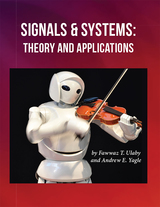
Signals and Systems
Theory and Applications
Fawwaz T. Ulaby and Andrew E. Yagle
Michigan Publishing Services, 2018
[From the Preface} This is a signals and systems textbook with a difference: Engineering applications of signals and systems are integrated into the presentation as equal partners with concepts and mathematical models, instead of just presenting the concepts and models and leaving the student to wonder how it all relates to engineering.
The first six chapters of this textbook cover the usual basic concepts of continuous-time signals and systems, including the Laplace and Fourier transforms. Chapters 7 and 8 present the discrete-time version of Chapters 1–6, emphasizing the similarities and analogies, and often using continuous-time results to derive discrete-time results. The two chapters serve to introduce the reader to the world of discrete-time signals and systems. Concepts highlighted in Chapters 1–8 include: compensator feedback configuration (Ch. 4); energy spectral density, group delay, expanded coverage of exponential Fourier series (Ch. 5); filtering of images, Hilbert transform, single-sideband (SSB), zero and first-order hold interpolation (Ch. 6); the Cooley-Tukey FFT (Ch. 7); bilateral z-transform and use for non-minimum-phase deconvolution (Ch. 8). Chapter 9 covers the usual concepts of discrete-time signal processing, including data windows, FIR and IIR filter design, multirate signal processing, and auto-correlation and crosscorrelation. It also includes some nontraditional concepts, including spectrograms, application of multirate signal processing, and the musical circle of fifths to audio signal processing, and some biomedical applications of autocorrelation and cross-correlation. Chapter 10 covers image processing, discrete-time wavelets (including the Smith-Barnwell condition and the Haar and Daubechies discrete-time wavelet expansions), and an introduction to compressed sensing. This is the first sophomore-junior level textbook the authors are aware of that allows students to apply compressed sensing concepts. Applications include: image denoising using 2-D filtering; image denoising using thresholding and shrinkage of image wavelet transforms; image deconvolution using Wiener filters; “valid” image deconvolution using ISTA; image inpainting; tomography and the projection-slice theorem, and image reconstruction from partial knowledge of 2-D DFT values. Problems allow students to apply these techniques to actual images and learn by doing, not by only reading.
The first six chapters of this textbook cover the usual basic concepts of continuous-time signals and systems, including the Laplace and Fourier transforms. Chapters 7 and 8 present the discrete-time version of Chapters 1–6, emphasizing the similarities and analogies, and often using continuous-time results to derive discrete-time results. The two chapters serve to introduce the reader to the world of discrete-time signals and systems. Concepts highlighted in Chapters 1–8 include: compensator feedback configuration (Ch. 4); energy spectral density, group delay, expanded coverage of exponential Fourier series (Ch. 5); filtering of images, Hilbert transform, single-sideband (SSB), zero and first-order hold interpolation (Ch. 6); the Cooley-Tukey FFT (Ch. 7); bilateral z-transform and use for non-minimum-phase deconvolution (Ch. 8). Chapter 9 covers the usual concepts of discrete-time signal processing, including data windows, FIR and IIR filter design, multirate signal processing, and auto-correlation and crosscorrelation. It also includes some nontraditional concepts, including spectrograms, application of multirate signal processing, and the musical circle of fifths to audio signal processing, and some biomedical applications of autocorrelation and cross-correlation. Chapter 10 covers image processing, discrete-time wavelets (including the Smith-Barnwell condition and the Haar and Daubechies discrete-time wavelet expansions), and an introduction to compressed sensing. This is the first sophomore-junior level textbook the authors are aware of that allows students to apply compressed sensing concepts. Applications include: image denoising using 2-D filtering; image denoising using thresholding and shrinkage of image wavelet transforms; image deconvolution using Wiener filters; “valid” image deconvolution using ISTA; image inpainting; tomography and the projection-slice theorem, and image reconstruction from partial knowledge of 2-D DFT values. Problems allow students to apply these techniques to actual images and learn by doing, not by only reading.
[more]
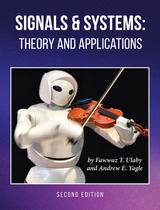
Signals and Systems
Theory and Applications
Fawwaz T. Ulaby and Andrew E. Yagle
Michigan Publishing Services, 2018
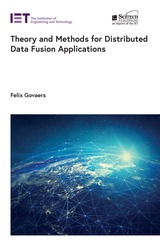
Theory and Methods for Distributed Data Fusion Applications
Felix Govaers
The Institution of Engineering and Technology, 2023
With the rise of digitalization, AI and modern data communication, engineering is increasingly challenged by the complexity of systems-of-systems, in which perception sensors have their own processing mechanism, information is merged at some centric entity, and cross-platform exchange of data is conceptualized in a holistic approach. Therefore, distributed architectures for data fusion, state estimation, and multi target tracking have been becoming increasingly important. The use of multiple sensors to perceive and compute the situational awareness picture leads to the generation of vast amounts of data, which need to be filtered, enriched, interpreted, and evaluated. This becomes infeasible without the notion of distributed algorithms.
[more]
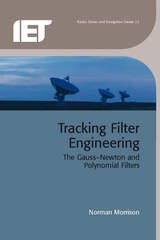
Tracking Filter Engineering
The Gauss-Newton and polynomial filters
Norman Morrison
The Institution of Engineering and Technology, 2013
This book provides a complete discussion of the Gauss-Newton filters, including all necessary theoretical background. This book also covers the expanding and fading memory polynomial filters based on the Legendre and Laguerre orthogonal polynomials, and how these can serve as pre-filters for Gauss-Newton. Of particular interest is a new approach to the tracking of manoeuvring targets that the Gauss-Newton filters make possible. Fourteen carefully constructed computer programs demonstrate the use and power of Gauss-Newton and the polynomial filters. Two of these also include Kalman and Swerling filters in addition to Gauss-Newton, all three of which process identical data that have been pre-filtered by polynomial filters. These two programs demonstrate Kalman and Swerling instability, to which Gauss-Newton is immune, and also the fact that if an attempt is made to forestall Kalman/Swerling instability by the use of a Q matrix, then they cease to be Cramér-Rao consistent and become less accurate than the always Cramér-Rao consistent Gauss-Newton filters.
[more]

Ultrawideband Radar Measurements
Analysis and processing
L.Y. Astanin
The Institution of Engineering and Technology, 1997
Interest in the applications of ultrawideband (UWB) radar systems is increasing rapidly all over the world. This is evident from the number of monographs recently published on the subject and from the many papers presented at international conferences on the general problems involved in UWB radar and on its promising new applications. Conventional (classical) methods seem to have exhausted their potential and studies in the field are undergoing a profound change. This book presents some of the novel approaches to radar system analysis now being investigated.
[more]
READERS
Browse our collection.
PUBLISHERS
See BiblioVault's publisher services.
STUDENT SERVICES
Files for college accessibility offices.
UChicago Accessibility Resources
home | accessibility | search | about | contact us
BiblioVault ® 2001 - 2024
The University of Chicago Press









